#400 b.c.
Text

~ Scaraboid gem/intaglio with griffin (set in modern gold loop).
Culture: Greek
Period: Classical
Date: 425–400 B.C.
Medium: Bronze
#ancient#ancient art#history#museum#archeology#ancient history#archaeology#greek#ancient greek#classical period#scaraboid gem#intaglio#griffin#425 b.c.#400 b.c.
866 notes
·
View notes
Text

March 10th 2023.
Today is International Bagpipes Day.
Bagpipes date back to 400 b.c. and are thought to originate in Egypt.

1 note
·
View note
Text
There are growing calls for Quesnel Mayor Ron Paull to resign after revelations his wife has been handing out a book that, according to promotional material from its publisher, questions whether residential schools were fundamentally harmful to Indigenous communities and people who attended them.
More than 200 people marched outside city hall Tuesday evening before packing into an emotionally charged council meeting in the city of roughly 23,000 people, located in B.C.'s Cariboo region about 400 kilometres north of Vancouver.
"We can no longer work with this mayor and we will not work with the City of Quesnel until [the] issue has been resolved," said Lhtako Dene Chief Clifford Lebrun.
"We can't have a community that hands out hate literature and expect people to listen to us and to take it seriously."
The meeting also heard from the mayor's wife, Pat Morton, and one of the authors featured in the book who had travelled to Quesnel to speak to council. [...]
Continue Reading.
Tagging: @politicsofcanada
#cdnpoli#British Columbia#Quesnel#Cariboo#Lhtako Dene#Indigenous politics#residential schools#genocide denial#First Nations
111 notes
·
View notes
Photo

Roman coin hoards, from the 'Coinage in the Roman Empire' project — 'hoards containing coinage in use in the Roman Empire between 30 B.C. and A.D. 400.'
358 notes
·
View notes
Text
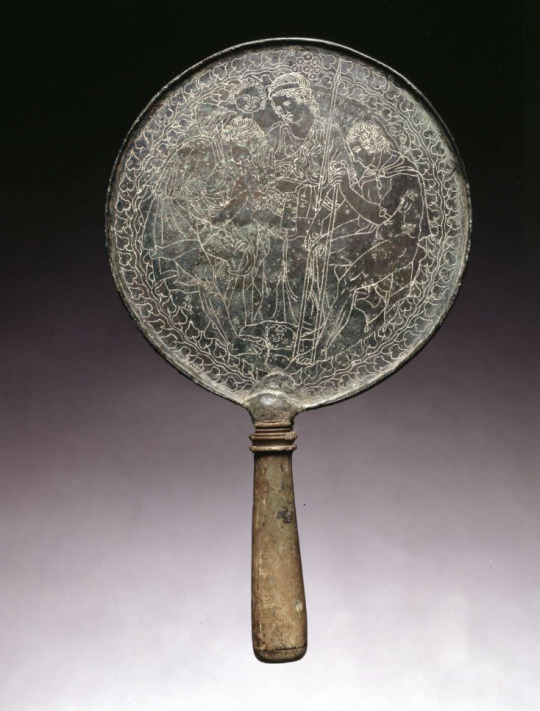
Bronze circular mirror with bone handle. Menerva (Athena) in the centre holding up the head of the Gorgon Medusa, with Ferse (Perseus) seated left and Turms (Hermes) seated right. Names are inscribed. Etruscan. c. 400-350 B.C. British Museum. 1888,1110.1
#etruscan#history#medusa#hermes#athena#mirror#ancient history#antiques#menerva#turnms#ferse#italy#roman empire#etruscan gods
424 notes
·
View notes
Text

Remnants of a ringed iron age hill fort built at Old Sarum, dated to 400 B.C., in Salisbury, England.
764 notes
·
View notes
Text

Remnants of a ringed iron age hill fort built at Old Sarum, dated to 400 B.C., plus later structural remnants, in Salisbury, England.
933 notes
·
View notes
Text
⚧️ The Gods & Gender ⚧️
Discussing Trans-Exclusive Radical Feminism and the views of the Gods is not "speaking for the Gods,"—it is looking at facts and information and drawing completely reasonable conclusions that squarely put the foundations of trans-exclusion in opposition to the Gods.
(definitely not audio proof read, sorry for the dyslexia)
🌿Aphrodite & Venus🌿
Aphroditos (or Aphroditus) is Aphrodite with male characteristics including a penis and/or beard.
A cult of Aphrodite included a bearded Aphrodite at Amathus, Cyprus on a high cliff temple. [Wikipedia citing Macrobius, Saturnalia III]
Her relationship with bisexuality (referring to being dual sex not sexual orientation in this paper), androgyny, and transvestism is also documented in Cyprus:
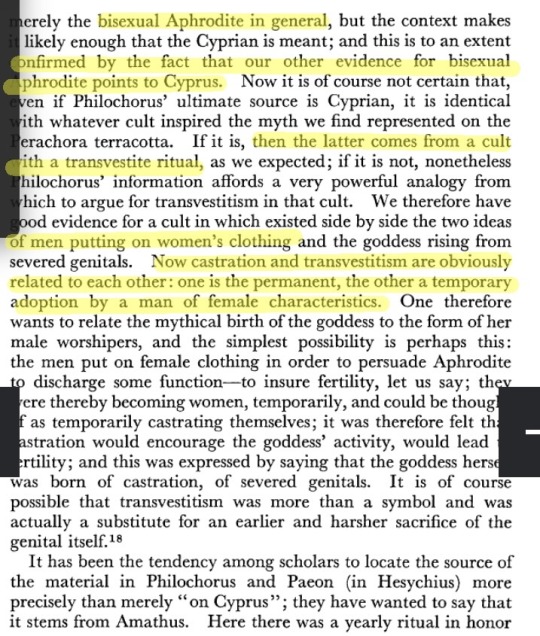
— Aphrodite in the Theogony by William Sale in Transactions and Proceedings of the American Philological Association Vol. 92 X
(Sorry for the shitty screenshot JSTOR did not want to work with me)
This worship of Aphrodite with a penis was also seen as equal to Venus:
There's also a statue of Venus on Cyprus, that's bearded, shaped and dressed like a woman, with scepter and male genitals, and they conceive her as both male and female. Aristophanes calls her Aphroditus, and Laevius says: Worshiping, then, the nurturing god Venus, whether she is male or female, just as the Moon is a nurturing goddess. In his Atthis Philochorus, too, states that she is the Moon and that men sacrifice to her in women's dress, women in men's, because she is held to be both male and female." — Macrobius (c. 400s AD), Saturnalia 3.8.2
🌿Hermaphroditus🌿
There is also the "intersex child of Aphrodite & Hermes" named Hermaphroditus.
I have seen many use Hermaphtoditus as an excuse to wipe away the Goddess Aphrodite with a penis that the ancients worshipped. Which doesn't even make sense because I hate to break it to you— Hemaphroditus also opposes TERF ideology by its nature. A God existing as bisexed/dual-sex/bigender (however you'd like to word it) negates the idea that the Gods somehow support the ridged biological essentialism and gender binary that TERF ideology necessitates.
There are different accounts of Hermaphtoditus' creation but one, Ovids, tells of him merging with a nymph and then asking his parents to make the water transformative causing men to have thr effeminate bodies like women:
Her prayer found gods to hear; both bodies merged in one, both blended in one form and face. As when a gardener sets a graft and sees growth seal the join and both mature together, thus, when in the fast embrace their limbs were knit, they two were two no more, nor man, nor woman--one body then that neither seemed and both. So when he saw the waters of the pool, where he had dived a man, had rendered him half woman and his limbs now weak and soft, raising his hands, Hermaphroditus cried, his voice unmanned, ‘Dear father [Hermes] and dear mother [Aphrodite], both of whose names I bear, grant me, your child, that whoso in these waters bathes a man emerge half woman, weakened instantly.’ Both parents hears; both, moved to gratify their bi-sexed son, his purpose to ensure, drugged the bright water with that power impure." — Ovid, Metamorphoses 4. 28 ff (trans. Melville) (Roman epic C1st B.C. to C1st A.D.)
🌿More on Aphroditos vs Hermaphroditus read @theoi-crow's excellent post about them here.
Also some lovely statues:
Marble copy statue from a fresco at Herculaneum, Italy. X (left)
Statue from Pergamum, Turkey. X (center)
Statue from Nymph Sanctuary in Lacori, Italy X (right)
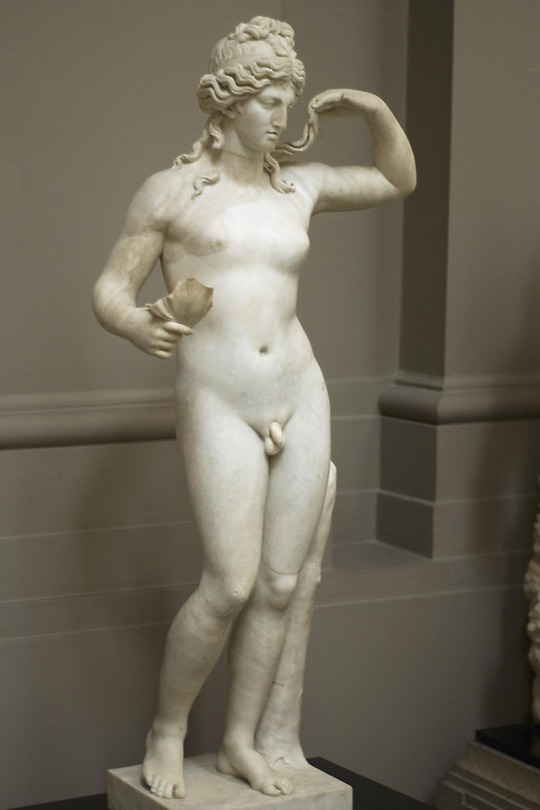
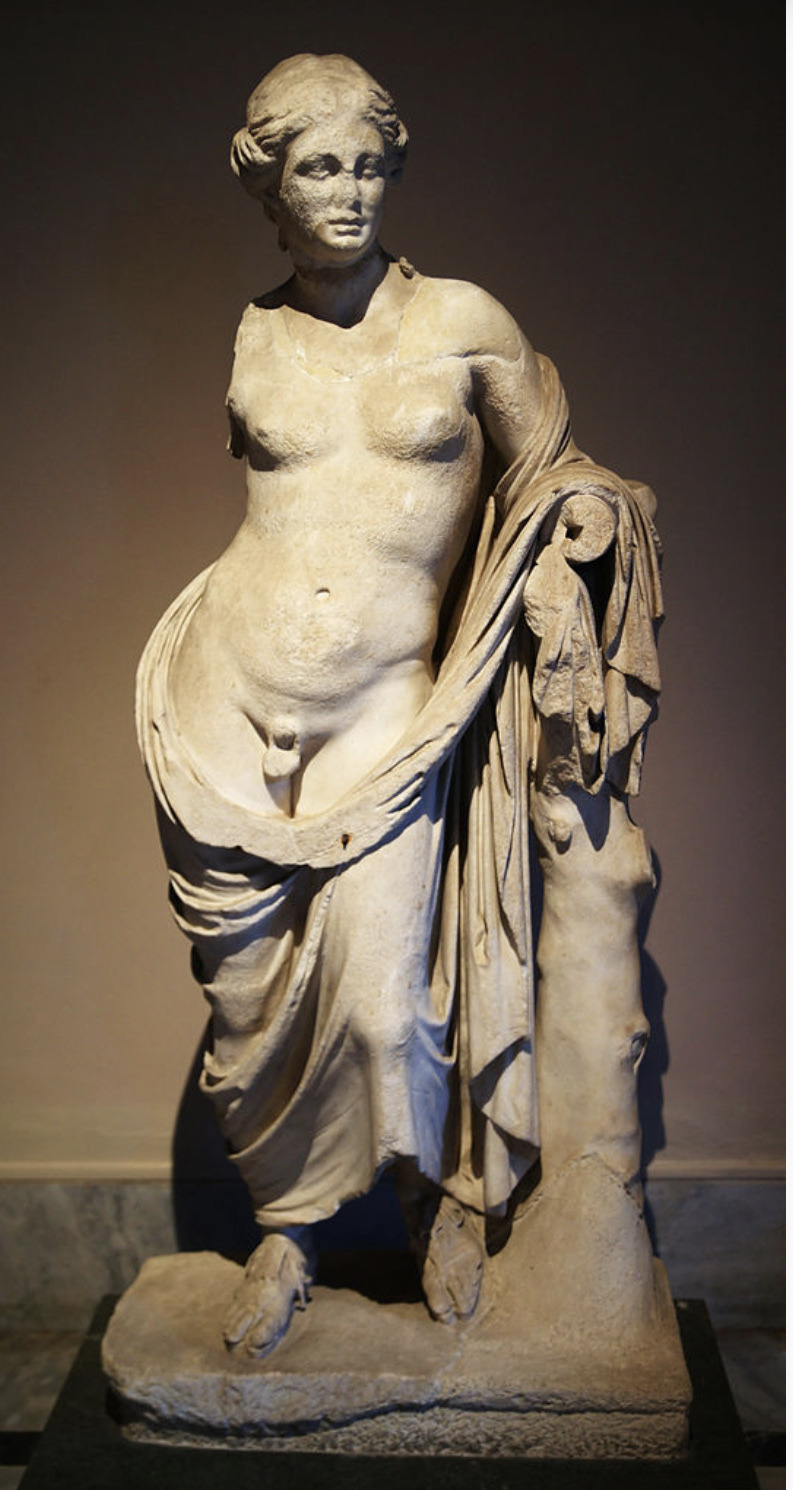
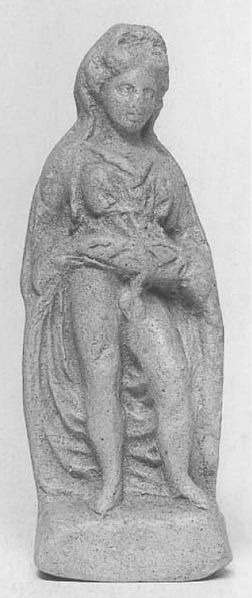
Statue from Pompeii, Italy X

🌿Inana & Ishtar🌿
From a hymn to Inana
To open up roads and paths, a place of peace for the journey, a companion for the weak, are yours, Inana. To keep paths and ways in good order, to shatter earth and to make it firm are yours, Inana. To destroy, to build up, to tear out and to settle are yours, Inana. To turn a man into a woman and a woman into a man are yours, Inana. Desirability and arousal, goods and property are yours, Inana. Gain, profit, great wealth and greater wealth are yours, Inana. Gaining wealth and having success in wealth, financial loss and reduced wealth are yours, Inana. Observation (1 ms. has instead: Everything), choice, offering, inspection and approval are yours, Inana. Assigning virility, dignity, guardian angels, protective deities and cult centres are yours, Inana. — A Hymn to Inana (Inana-C) ETCSL 4.07.3 in Lines 115-131.
This shows:
Inana has the power to change a person's gender/sex .... which means people can change gender/sex
This is listed among other normal things such as journeys, wealth, settlements so on. Suggesting that it wasn't super special, it was a part of Sumerian society that Inana was given power over.
This was written by Enheduanna High Priestess of Nanna, Ur's city God, and Inana. Inana was a popular Sumerian deity and Enhenduanna's father, Sargon of Akkad's, personal deity was Ištar. One of Enhenduanna's goals as a priestess was to conflate the popular Sumerian deity Inana with her father's Akkadian personal Goddess Ištar. Then raise Inana (and thus her father's personal Goddess Ištar) to an extremely high place in cosmology and explain just how much control she had in society— including over sex/gender.
Also from @sisterofiris's post on Inana's queer priests here.
🌿Nanaya🌿
In later times Inana/Ištar was equated with Nanaya but in earlier times they were worshipped side by side as separate deities. While Inana's hymn gives her rule of gender, a Nanaya hymn has her directly declaring she has breasts in Dadumu and a beard in Babylon. Leick also mentions here that Ištar was worshipped in both genders.

—Dictionary of Ancient Near Eastern Mythology by Gwendolyn Leick. Page 125.
🌿Asūšunamir with Ereškigal🌿
In Ištar's Descent (not Inana's) Ea's plan to distract Ereškigal and get her to bring Inana back to life is to make a beautiful being. Ea makes an incredibly beautifully brilliant being that's mere aesthetic presence will make Ereškigal happy and let her defenses down. And Asūšunamir's beauty works..... and he is an eunuch, an effeminate male, potentially queer from the ancient's eyes. And yet he is so beautiful he distracts a Goddess.

— The Ancient Near East and Anyhology of Texts and Pictures, edited by Pritchard. Ishtar Descent translation by E.A Speiser. Page 80.
🌿Eštan / Ištanu🌿
The Anatolians (Hittite in particular) loved to both mix deities and keep them entirely dependent like 8 solar deities and 50 storm Gods. But sometimes Hittite, Hurrian, Hattic, Indo-European, Mesopotamian all meld together making the identification of gender ambiguous or even interchangeable.
Eštan is one example (who has numerous equatings):

—A Handbook of Gods and Goddesses of The Ancient Near East by Frayne & Stuckey. Page 105
You can also learn more about the Ištanu and the Sun Goddess of Arinna and her gender from @sisterofiris in a post here.
__
I'm sure there are more! But this was my quick round up and sources I could put together. To all the trans & non-binary polytheists out there, you aren't abnormal and the Gods see you for who you truly are.
Edit: Want some more? Learn about the feminine qualities of Apollo
#polytheism#paganism#helpol#lgbtq#hellenic polytheism#mesopotamian#disc horse#lgbt+#queer#landof2rivers#ofthetheoi
454 notes
·
View notes
Text
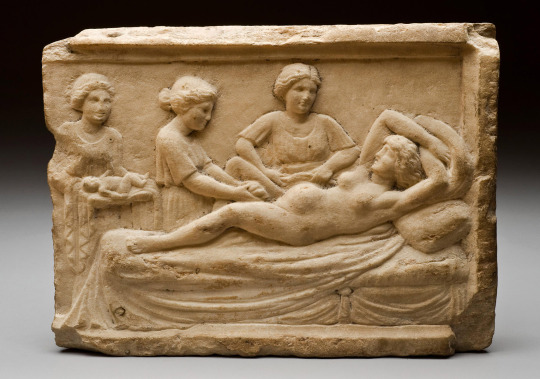
~ Relief with a parturition scene.
Date: 400 B.C.-A.D. 300
Place of origin: Ostia
Medium: Marble
Provinience: London, Science Museum
#ancient#ancient art#history#museum#archeology#ancient sculpture#ancient history#archaeology#relief#parturition#giving birth#ostia#marble#400 b.c.#a.d. 300
696 notes
·
View notes
Text



Head of an Alexander the Great, Konuralp, Turkey
Marble, 2nd Century
Alexander was one of the most famous rulers of the ancient world. Born in 356 B.C., he became the king of Macedonia, a territory north of Greece, in 336. His father, Philip II of Macedon, had already succeeded in uniting Greece under his rule.
Although not born in Greece, Alexander was enamored of Greek culture and spread it as he began a campaign of military conquests to the south and east, which culminated in his defeat of the powerful Persian Empire in a series of battles between 334 B.C. and 331 B.C.
Alexander the Great died in 323 B.C, so the statue may have been made more than 400 years after his death.
Image credit: Düzce Municipality
#art#history#style#archeology#sculpture#head#alexander the great#turkey#konuralp#2nd century#hairstyle#macedinia
80 notes
·
View notes
Photo

Embroidered textile feline, Nazca, ca. 200 B.C.–A.D. 400, camelid fiber
Princeton University Art Museum, New Jersey
701 notes
·
View notes
Text

This winged feline (500–400 B.C.) originally served as the front leg of a wooden chair or throne. Felines were popular in the art of many Mediterranean and Near Eastern cultures. Certain stylistic features of this piece, as well as the manner in which it was made from separate pieces of bronze joined together, suggest that this work was created in Spain, specifically in the kingdom of Tartessos. The form of the feline's brow is a Tartessian characteristic, as is the triangle design in the creature's ear. Image by Getty Museum.
Learn more / Daha fazlası
Tartessos https://www.archaeologs.com/w/tartessos/
#archaeologs#archaeology#archaeological#dictionary#history#art#mediterranean#culture#tartessos#spain#iberia#tartesian#arkeoloji#tarih#sanat#ispanya
61 notes
·
View notes
Text
A Vancouver parent has launched a proposed class-action lawsuit against the makers of Fortnite, saying the popular video game is designed to be "as addictive as possible" for children.
In the lawsuit filed in B.C. Supreme Court on Friday, the plaintiff — identified only by the initials "A.B." — says her son downloaded Fortnite in 2018 and "developed an adverse dependence on the game."
The game, with 400 million players worldwide, is free to download and play but sells things like character costumes and dance moves for money.
Full article
Tagging: @politicsofcanada
#cdnpoli#canadian politics#canada#canadian news#canadian#british columbia#vancouver#BC#fortnite#gaming#video games
858 notes
·
View notes
Photo

Tanagra Figure of Aphrodite with Two Cupids, Unknown, Greece, 400 B.C., Sculpture, Terracotta.
959 notes
·
View notes
Text

Marble sarcophagus lid of a possible priestess, Carthage, c. 400-300 b.c.
#north africa#mediterranean#ancient mediterranean#tunisia#carthage#sarcophagus#history#priestess#winged lady
88 notes
·
View notes
